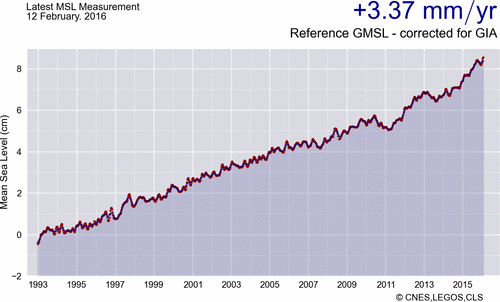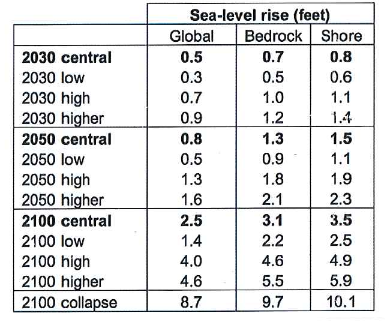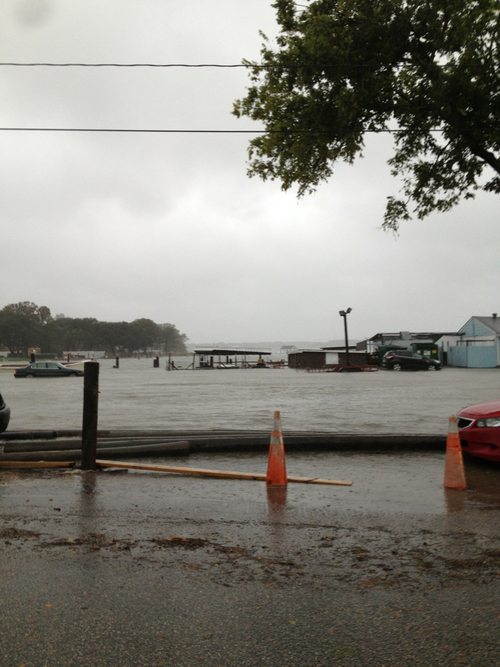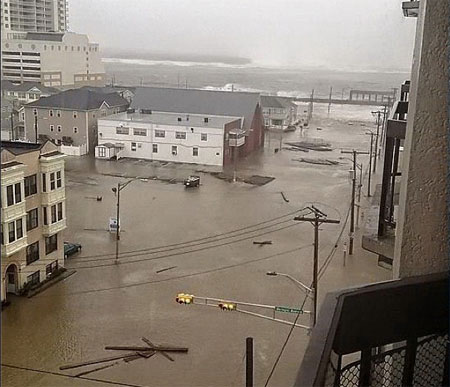Around the world seas are rising. Fed by human warming, the great waters have been pushed to thermally expand. The added heat is melting the glaciers as well. And from the high mountains to the Arctic and on into the Antarctic there are few ice masses now that have been untouched by the rising temperatures.
The rise in ocean heights began as human fossil fuel emissions spread into the airs of the early 20th Century — warming both the atmosphere and the waters. The rate of rise was, at first, slow — less than 1 mm per year. But as the greenhouse gasses built up and rates of global heating increased, so did the annual rate of sea level rise. By the end of the 20th Century, sea level rise had more than tripled to about 2.9 mm per year. And by today that annual rate of increase has accelerated to nearly 3.4 mm per year.
(AVISO sea level rise graph shows rate of ocean rise again increasing in the 2010 to 2016 timeframe. It is very likely that glacial destabilization will result in ever-more-rapidly rising ocean waters as the 21st Century progresses. Image source: AVISO.)
The slow sea level rise rates during the 20th Century were manageable. Coastal communities were mostly built on high enough ground to give them some protective margin against the gradually rising tides. But now, for many cities along the US coast and upon its bays and estuaries, a kind of tipping point has been reached. Where it took a moderate-to-strong storm to generate flooding in the past, now only a high tide and a bit of onshore wind will suffice.
This issue is not just a problem for places like Miami and South Florida or New Orleans and the Louisiana Delta. It’s a problem for the entire coastline. And though the lowest-lying areas were affected first, more and more regions are starting to fall below the line of the rising tide.
A Seasonal High Tide Now is Enough to Flood Atlantic City
Such was the situation today in Atlantic City, New Jersey. There, a weak off-shore low pressure system pushed an equally weak wind toward shore. The meager flux of water driven by this mild fetch combined with a seasonal high tide. Together, these entirely normal events were enough to flood streets throughout Atlantic City.
(Arizona avenue floods this morning in Atlantic City. By evening, water levels are expected to have risen even higher. Image source: City of Atlantic.)
The flood began as storm drains dumping into local estuaries started to back up. The rising tide ran up the drains and inundated streets and neighborhoods, causing 1-3 feet of flooding in some areas. Cindy Nevitt — an award-winning Cape May reporter tweeted: “I haven’t seen my street for three days… Forecast for tonight is even worse.”
The flooding was extreme enough to cause road closures and to spark a flurry of social media comments on Twitter. Particularly hard-hit were the neighborhoods of West End and North Wildwood. To be very clear, this is no hurricane, no Superstorm Sandy, just a normal high tide riding on the back of an entirely abnormal sea level rise due to human-caused climate change.
This kind of flooding is not enough to cause major damage. But it is cause for concern. For now, Atlantic City is far more vulnerable to storms and to flooding than it has ever been in the past. And with human warming due to fossil fuel burning continuing to push seas higher, Atlantic City, like so many other US Coastal communities will, sooner or later, face the threat of total inundation.
City Could be Lost by 2030 to 2050, Unlikely to Remain Viable to 2100
For in the far south, the glaciers of Antarctica are starting to rapidly destabilize. And, in the north, Greenland melt is also rapidly accelerating. Due to the way gravity affects the world’s oceans, Antarctic melt will have the greatest effect on base sea level rise in the North Atlantic. Meanwhile, Greenland melt risks backing up the Gulf Stream and contributing to up to 3 feet of additional sea level rise on the US East Coast as water rebounds toward shore.
(Possible sea level rise scenarios as envisioned by a recent Rutgers study. A number of scientists, including Dr. James Hansen, points to even more extreme potentials. Image source: Sea Level Rise in New Jersey Fact Sheet.)
By as soon as 2030, seas could be as much as 1.4 feet higher than they are today in the Atlantic City region. And if the worst case scenario that scientists like James Hansen have warned us about come to pass, then by 2100 seas will have completely covered Atlantic City with a multimeter ocean rise. Put in context, by 2030 seasonal tidal flooding seen today is likely to become monthly tidal flooding by 2030. And between 2030 and 2050, such flooding will become a daily event rending most infrastructure useless and likely resulting in a complete loss of the City’s ability to function.
But even before then, one large storm may complete what hundreds of tides would eventually accomplish. For garden variety nor’easters will grow more and more capable of producing the kind of catastrophic flooding seen during Superstorm Sandy as the years progress.
It’s probably true that we’ve already burned enough fossil fuels to generate sea levels high enough to inundate many cities near or on the coastline. But continuing to burn fossil fuels makes the situation worse and far more immediate. Stopping that continued bleed of heat trapping gasses into the Earth’s atmosphere gives communities like Atlantic City a chance — if not to survive long-term against an inevitably rising tide, then to figure out a way to orderly retreat inland and to at least preserve some of the heritage that is now falling under threat from the inexorably rising waters. And such a necessary cessation would give communities still further inland a reasonable hope that they, unlike Atlantic City, will not share the fate of Atlantis.
Links:
Sea Level Rise in New Jersey Fact Sheet
Hat tip to Griffin





















